Posted on June 22, 2023
Updated on June 22, 2023
8 min read time
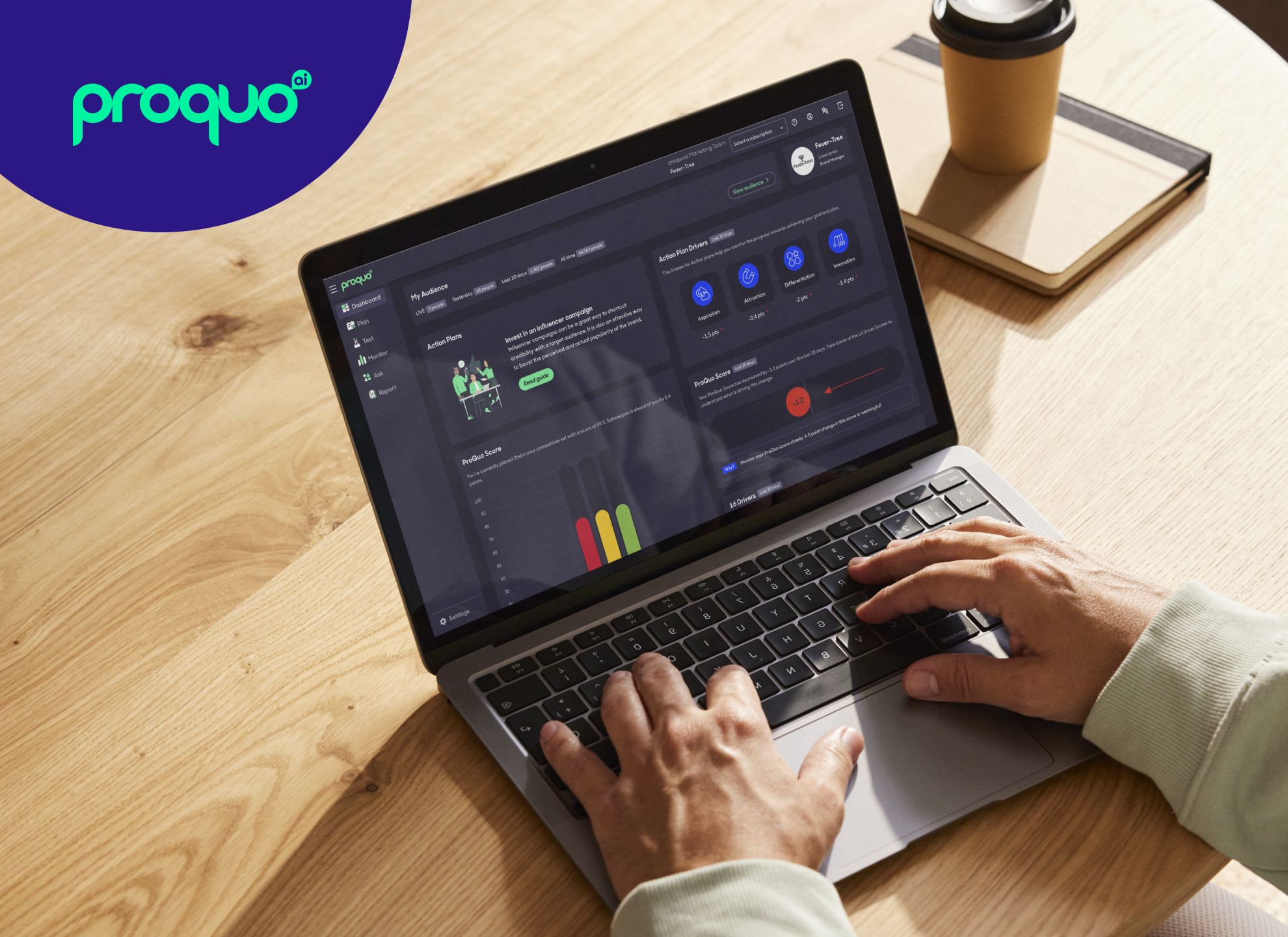
What do Aristotle and marketing have in common? The great Greek philosopher once said, "Knowing yourself is the beginning of all wisdom." And that's true for any brand. Can you confidently say you know how your brand performs in its category and market? What's your brand's reputation and recall? Are your customers satisfied and loyal?
This is where different types of brand intelligence come into play!
From this article, you'll learn about the most important metrics you should measure to understand and improve your brand equity. Many traditional practices for understanding these metrics include website analytics, social media monitoring, brand trackers, and monthly or quarterly consumer insights reports. However, to actively navigate constant market and consumer behavior changes, you must act on real-time data from your users and potential customers.
At ProQuo, we have developed a brand equity model that not only measures overall brand strength, but also the individual drivers that comprise it, leading to metrics that explain “whys” and leave you knowing what to do next. Today, we'll show you how you can apply our 16 Drivers of Brand Equity to measure brand health metrics in real-time, over time, and against your competition. The 16 Drivers of Brand Equity are based on neuroscience and the rigorous study of thousands of brands daily to give you granularity into how your brand performs.
We wrote an article discussing whether brand equity needs to be revamped some time ago. The consensus was that to build excellent brand equity, you need to take care of the many aspects of your relationship with your consumers. That's one of the insights that led to the creation of our real-time brand health tracker.
In short, brand equity is the value of your brand. It encompasses all the aspects we'll consider here today. Brand awareness enables you to reach your consumers. When your brand is relevant, and customers are satisfied, it promotes brand advocacy. Your brand sentiment and reputation also affect your bottom line.
So how to ensure your brand equity measurement accounts for all these metrics?
ProQuo AI’s Brand Equity Score is your point of reference. It analyzes all 16 Drivers of Brand Equity to give you a single Score. It shows how your brand performs against your competition, and consumers’ expectations, in real time and over time.
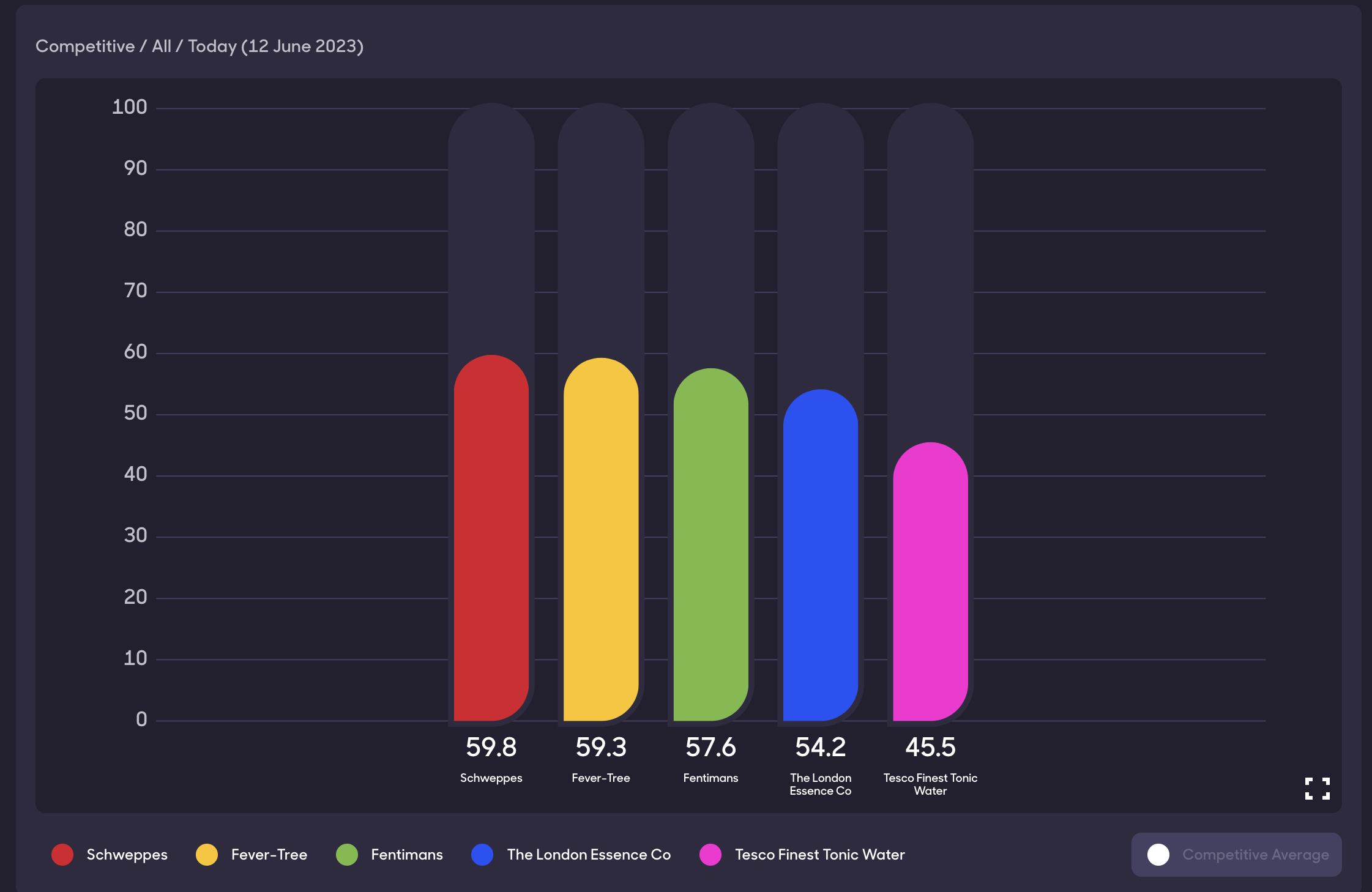
(A bar chart displaying the respective brand equity scores of brands in the Tonic Water Mixer category)
Now, let’s consider the most important brand equity metrics and how our Drivers correlate and give you insights into your performance.
Let's start with awareness.
It's easier to sell products online if consumers are aware of your brand. In fact, 30% of customers have a brand in mind when shopping. It means the fight for consumers' attention begins before the purchase occurs. That is why brand awareness is the fundamental marketing activity for any brand.
Effective brand awareness tactics can make your brand stand out, which translates into gaining new customers. The increased visibility of your brand also builds trust. Your brand is no longer just a name; you create an emotional as well as a rational connection with the consumer.
Good indicators of brand awareness are our Familiarity, Differentiation, and Attraction Equity Drivers. Familiarity refers to the depth of knowledge people have about your brand. Differentiation indicates how you stand out against your category and industry competition. While Attraction is all about the look and feel of your brand and how memorable it is. When you see these Drivers increase, it’s highly likely that you’ll see a rise in brand awareness.
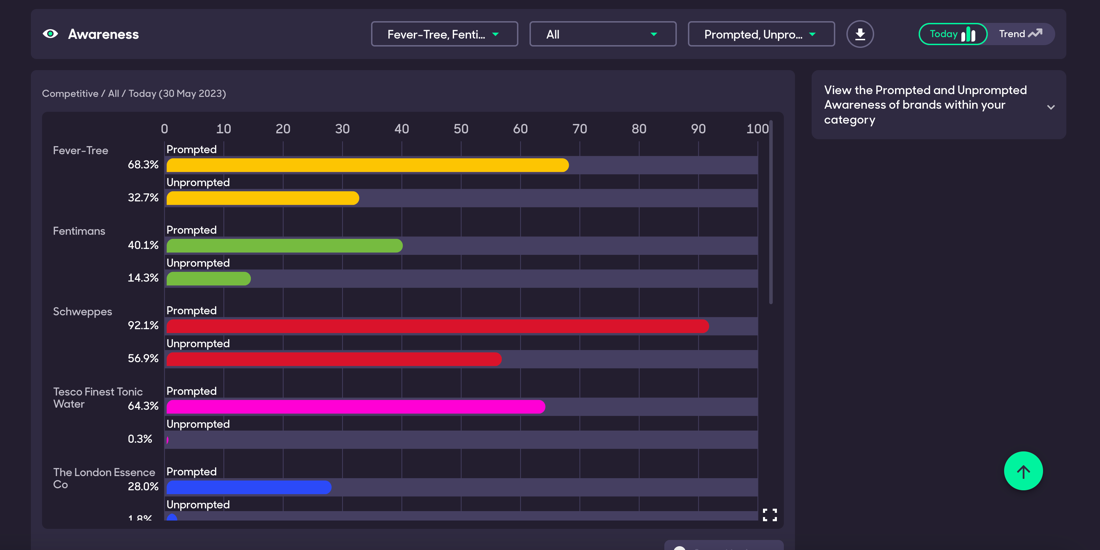
(A bar chart displaying the 'prompted' and 'unprompted' awareness of the Tonic Water / Mixer category)
Apart from these Drivers, you can measure pure unprompted and prompted brand recall on our platform.
Prompted awareness presents respondents with a product category, service, or specific circumstance and asks for associations. While unprompted awareness is asking people to name as many brands as they can think of in a category.
You can increase brand recall by:
You can measure brand recall against your competition, in real time and over time, to get a full picture of how top-of-mind your brand is for your existing consumers and potential customers.
Similar to market share, the share of voice (SoV) refers to the percentage of attention a company or brand has within its category or industry. With a social listening tool, you can measure yourself against the competition in terms of how many mentions and comments you receive.
You can also measure brand’s SoV with our Popularity Driver. Popularity is based on the buzz or cultural momentum surrounding a brand. People are naturally attracted to things that others enjoy. It's important to note that a brand doesn't have to be big to rank highly in Popularity.
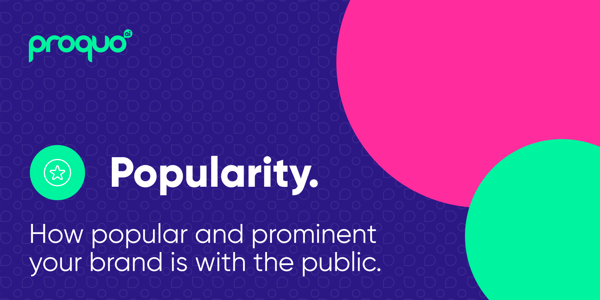
If you score lower than expected on Popularity, ProQuo has ready-to-go action plans, including one to grow category market share. It will define which Drivers you should focus on and what activities to pursue to increase them. Working on these Drivers can increase your share of voice.
Brand sentiment refers to the emotions customers have towards your brand. One common brand sentiment analysis option is social listening, whereby you can search the Internet for mentions of your brand, both positive and negative. However, social listening & scraping only provides extreme views — positive or negative. The balanced average is lost as there is always something which has prompted people to post/comment. You are missing upwards of 80% of comments in some cases.
With our platform, you can ask questions and receive qualitative responses. All answers will be automatically sorted into positive and negative sentiment. Because ProQuo talks to a representative sample of your target population, responses on ProQuo are more moderate and nuanced than those posted on social media, giving you a balanced picture of how your brand is perceived.
You can also look at sentiment through the perspective of Aspiration and Empathy Drivers.
Aspiration measures how consumers feel about your brand and how they are perceived. If they are excited about the purchase; if they cannot wait to wear or taste your products. Nike is a great example here. The "Just Do It" slogan aims to empower those working out in their shoes or clothes. It isn't necessarily about the product's quality but the associated emotions.
To create an aspirational brand, consider:
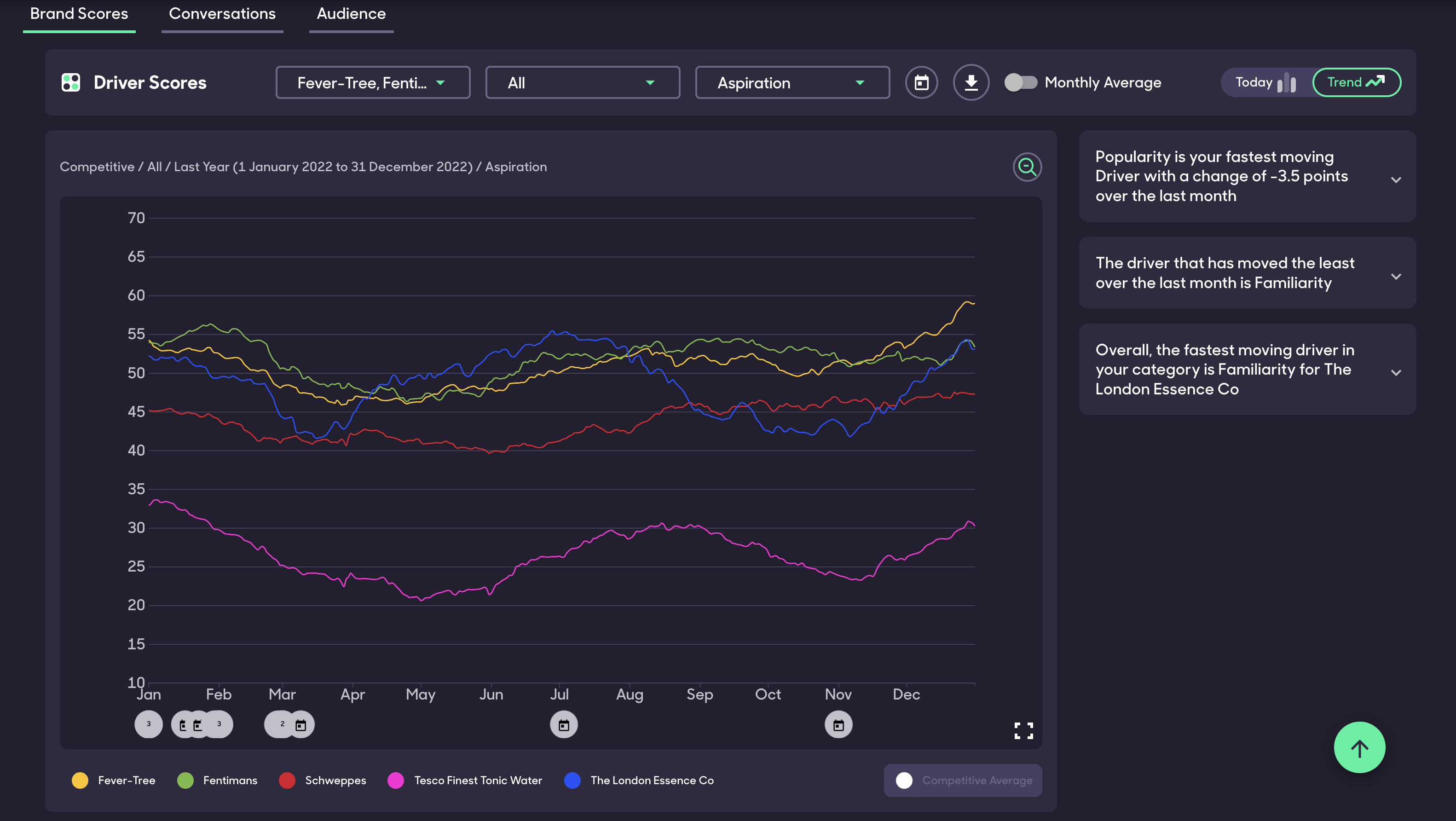
(A graph showing the change in Aspiration driver score for the Tonic Water Mixer category over the course of 2022).
Empathy refers to how well your brand understands its buyers, their wants and needs. To get a clear picture of the Empathy driver, you can ask direct questions to your consumers via ProQuo AI. You can get 300 answers to open-ended questions daily. All the responses are categorized by sentiment thanks to Natural Language Processing. You can also have a quick look at the most common words or phrases used by people.
While brand sentiment refers to the emotional connection with your consumers, reputation is about rational thinking. Like brand sentiment, social monitoring enables you to predict and face PR crises or bad reviews. People will also look at the Integrity and Transparency of your brand and the Performance of your products.
Integrity and Transparency are closely connected. These Drivers indicate the overall perception of your brand's character. Unsimilar to humans, trust is difficult to earn when a company lacks these qualities. Integrity is about doing the right thing, while Transparency is honesty.
The way you communicate with your consumers will pay dividends. Being open about your company's inner workings, and how it treats people and makes decisions will help consumers "get" your brand. And if you're involved in any CSR initiatives, make sure that it stems from the nature of the brand and people involved, not scoring PR points. People are great at seeing through your actions.
It might be a cliché, but reputation is hard to get and easy to lose. And the Performance of your product can quickly turn devotion into indifference. At ProQuo AI, we understand this as how your brand delivers on its promises, which you can measure with the Performance Driver.
Brand relevance describes how much the intended audience views a brand as important and relevant. It measures how well the brand can engage with consumers, meet their requirements, and remain up-to-date in a constantly changing market setting.
Understanding how important that metric is, we also apply the Relevance Driver to measure how your brand meets the needs of its consumers. Maintaining Relevance is critical to driving repeat purchases and loyal customers.
To ensure your brand is relevant, consider the following:
Speaking about returning customers and repeat purchases, customer satisfaction and loyalty are one of the most important metrics in any industry.
The most common way of measuring customer satisfaction is the Net Promoter Score. This widely adopted solution asks people if they would recommend a company/brand/product to others. Keeping everything under one roof, you can conduct such surveys on the ProQuo AI platform. You can combine the NPS question with a qualitative one like “why would you recommend/not recommend this brand”. That’s a more actionable approach.
It's also a good idea to monitor and analyse customer feedback on review sites, as well as customer retention and repeated purchase rates in a CRM.
Other metrics that can be measured include:
Customers value different aspects of the brand, which means many Drivers can come into play here. However, we wanted to focus on Consistency and Accessibility Drivers. With these, you can assess whether your brand is reliable, and your products are easy to use. In addition, customer experience teams can benefit from monitoring these Drivers daily, monthly, and quarterly.
Customer satisfaction and loyalty can turn customers into brand advocates—free promotion of your brand at its finest. With brand advocates, you can increase your credibility and trust, online and offline engagement, and build a community around your brand.
You can measure advocacy by:

In terms of ProQuo AI, a good indicator of brand advocacy is the Connection Driver. It refers to consumers' identification with brands' behavior. Through social listening and quick questions on our platform, you can understand how your consumers react to your actions or planned initiatives, like your stance on sustainability. With the Connection Driver, you can verify if your online presence resonates with your consumers and whether your competition is ahead or if you're the leader in that regard.
A consumer's purchase intent reveals their level of interest and commitment toward buying a particular product or service. This likelihood of purchasing in the future is an essential metric for businesses to consider when evaluating their marketing strategies.
One of the ways to measure purchase intent is through our Value-for-Money Driver. It's an important aspect of any product or service. Especially now, since the cost-of-living crisis is impacting consumers.
Running intent-based ads, such as Pay-per-click, is a good way to measure how your offering is performing, including the visual aspects, the messaging behind it, and whether your consumer insights are correct. In addition, your conversion rates will indicate how well you're faring against the competition.
But before spending any money, verifying whether your creatives will resonate with consumers is a good place to start. With the testing component of ProQuo AI, you can A/B test your creative assets before launching any paid campaigns and ask people specific questions about them to understand exactly what they liked or didn't like. This way, you are only investing in the creatives proven to work.
If that sounds interesting, don't hesitate to book a demo and uncover what your consumers want & how they feel in real time, and what your Brand Equity Score is!
Our intelligent platform will take your brand further, faster.
Don’t believe us?
© 2020-2023 ProQuo AI International
All rights reservedWebsite by Blend